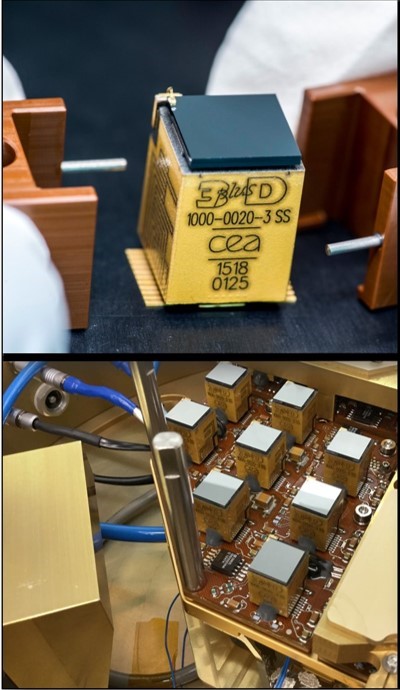Objectives of the joint laboratory
The ALB3DO1 laboratory is the fruit of a collaboration between the CEA and 3D PLUS. Using their "Caliste" detector technology, ALB3DO has set itself the scientific objectives of producing in the short term a demonstrator for a very high-performance portable gamma camera (with the first prototype available in 2022) and of leading research to develop new X-ray and gamma-ray detectors with very high pixel density.
The work begun at ALB3DO aims to develop Caliste for:
radiation monitoring in the nuclear field. The demonstrator could be used to locate and identify radioactive sources, measuring their energy levels. The data would be viewable in real time on a screen, meeting various nuclear industry needs such as radioactive leakage monitoring, radioactive waste management, and dismantling. It constitutes a major technological advance for personnel safety since it improves the practices of radiation protection services and the protection of workers exposed to ionising radiation at nuclear power plants;
Based at the CEA Paris-Saclay site and at 3D PLUS in Buc (Essonne), from late 2020 ALB3DO will start to welcome the physicists, engineers, technicians, doctoral researchers and interns involved in the project, including five new employees currently being recruited. In five years' time, this activity should involve around thirty employees.

Caliste module in the Solar Orbiter mission's STIX camera.
Photo credits: L.Godart/CEA
Background of the collaboration
For more than 15 years, the joint work done by teams at the CEA and 3D PLUS has pushed the limits of spectro-imager performance to the highest international level for space applications2. Several generations of Caliste X-ray and gamma-ray detection modules have emerged from this collaboration between research and industry. The most recent Caliste to go into space equips the focal plane of the STIX instrument, installed on board the Solar Orbiter mission run by the ESA (European Space Agency), which launched from Cape Canaveral in February 2020. The Caliste detectors have been revolutionary for high-energy astronomy: their small pixel size means that these instruments offer an image quality, event dating precision, sensitivity and energy measurement precision for each photon that has never previously been achieved;
1 Advanced Laboratory for 3D Detection Device Developments
2 Fine-pitch hard X-ray and gamma-ray detectors based on cadmium telluride (CdTe) semiconductors, read by low-noise microcircuits specially designed by the CEA at the Institute of Research into the Fundamental Laws of the Universe (Irfu) and assembled into miniature hybrid components based on the 3D integration technology of the company 3D PLUS.